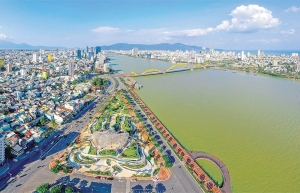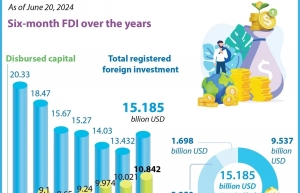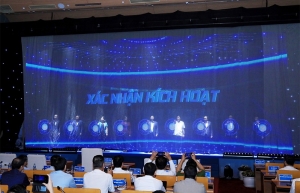Fund policies to help boost tech investing
At a meeting with Prime Minister Pham Minh Chinh on his official visit to South Korea in early July, chairman of Samsung Group Lee Jae Yong confirmed long-term additional investment in Vietnam.
 |
| Vietnam and all other nations have had to contend with a new global tax regime this year, Photo: Shutterstock |
“We plan to invest strongly in the next three years to enable Vietnam’s factories to become the group’s largest display module production base globally,” Yong emphasised.
The detailed amount was not revealed but in recent years, every decision of Samsung, the biggest foreign investor in Vietnam with a total investment of $22.4 billion, is often worth billions of US dollars.
Other South Korean giants also have big plans to invest in Vietnam, with LG Display CEO Cheoldong Jeong saying that the country is LG’s key global production location.
Of the total registered capital of more than $8 billion, LG has already disbursed more than $5 billion and is planning to pour more in the coming time. Of this, LG Innotek factory in the northern city of Haiphong will double its capacity to become a closed LG production complex, Jeong confirmed.
To enhance competitiveness, the Ministry of Planning and Investment (MPI) is building policy on the establishment of an investment support fund, which is based on additional revenue from the global minimum tax and other state budget sources, like deposit interest, revenue from public service activities, sponsorship contributions, and annual fund residuals. The fund would operate in the form of direct cash payments to support training costs, human resource development, research, investment in fixed assets, production of high-tech products, and investment in social infrastructure.
“Financial support and investment subsidies will not be paid immediately to businesses but based on the results of project implementation (disbursement progress and revenue) and attached with some conditions,” the MPI highlighted.
“With flexible incentive policies, we expect to lure more large-scale projects in high technology,” said Do Thanh Trung, Deputy Minister of Planning and Investment.
Elsewhere, Amkor Technology Singapore Holdings will raise capital by $1.07 billion for a factory for manufacturing, assembling, and testing semiconductor materials and equipment, not long after putting the first phase into operation at the end of 2023. Numerous South Korean corporations have also confirmed expansion plans in recent times after pouring billions of US dollars into Vietnam. CJ remains investing in the food sector, Posco wants to participate in mining and processing rare earths in Vietnam, and Daewoo E&C Group plans to develop a new urban area in the northern province of Thai Binh.
Hyosung Group also plans to develop data centre services in Saigon High-Tech Park with an expected scale of 1,500-4,000 racks, meeting strict international standards, and serving the specific needs of super-large customers.
Ho Chi Minh City has become an attractive destination for technology giants, with proposals in semiconductors and data centres. In early July, a delegation of Nvidia Corporation from the US led by Ettikan Karuppiah, chief technology officer for the Asia-Pacific region, arrived in the city to review investment destination. This was the second meeting of Nvidia since the beginning of the year. The delegation worked with numerous technical universities and companies to discuss cooperation possibilities in the future, as well as met with Ho Chi Minh City People’s Committee to discuss training and developing AI, supporting startups in AI, and establishing an AI centre of excellence.
“Nvidia aims to establish a centre for research and development, and training on AI; install supercomputer systems; and relocate a part of the production of processing units for supercomputers to Vietnam,” Karuppiah said.
Another US tech giant, Marvell Group, is also accelerating the expansion of chip design centres in Vietnam. In May, it announced the opening of an additional chip design centre in the central city of Danang, following two centres in Ho Chi Minh City.
Le Quang Dam, CEO of Marvell Technology Vietnam, said that since the beginning of the year, Marvell’s integrated circuit (IC) design personnel in Vietnam has increased by more than 30 per cent.
“Marvell Vietnam aims to become Marvell’s third largest IC design centre globally in the next few years, following the major centres in the United States and the Indian branch,” Dam stated.
Design centres in Vietnam will focus on designing new IC technology chips, such as optical connectivity, storage, analogue and mixed-signal semiconductor technology, which are key technologies in accelerating the construction of new infrastructure to meet the increasing demand for performance and speed of cloud data centres and AI.
 | Free trade zone becomes lever for FDI attraction in Danang The central city of Danang will have opportunities to draw in more investment following approval to establish a free trade zone, with pilot preferential mechanisms to woo high-tech projects. |
 | FDI inflow into Vietnam reaches nearly 15.2 billion USD Vietnam attracted nearly 15.2 billion USD in foreign direct investment (FDI) in the first six months of this year, a year-on-year increase of 13.1 per cent, according to the General Statistics Office. |
 | Hanoi to expand IPs to welcome FDI Hanoi will continue to expand industrial park and cluster infrastructure to welcome foreign direct investment inflows. |
What the stars mean:
★ Poor ★ ★ Promising ★★★ Good ★★★★ Very good ★★★★★ Exceptional
Related Contents
Latest News
More News
- EVN launches major power infrastructure projects nationwide (December 19, 2025 | 18:17)
- VAL inaugurates second production line to meet domestic animal feed demand (December 19, 2025 | 16:37)
- Sun Group pioneers urban tram system in Phu Quoc (December 19, 2025 | 15:00)
- Seven major projects launched to drive Hanoi’s next growth phase (December 19, 2025 | 14:00)
- Securing capital and efficiency for Vietnam’s 2026-2030 growth ambitions (December 17, 2025 | 10:00)
- Vietnam bucking trend in the global M&A landscape (December 16, 2025 | 14:20)
- HDS Summit spotlights Vietnam’s rising role in regional supply chains (December 16, 2025 | 08:00)
- Kolon signs $48 million airbag supply deal with Autoliv (December 15, 2025 | 18:14)
- National Assembly approves Vinh–Thanh Thuy expressway project (December 15, 2025 | 18:02)
- Quang Tri green-lights $1.59 billion LNG-fired power project (December 15, 2025 | 17:59)

 Tag:
Tag:




















 Mobile Version
Mobile Version